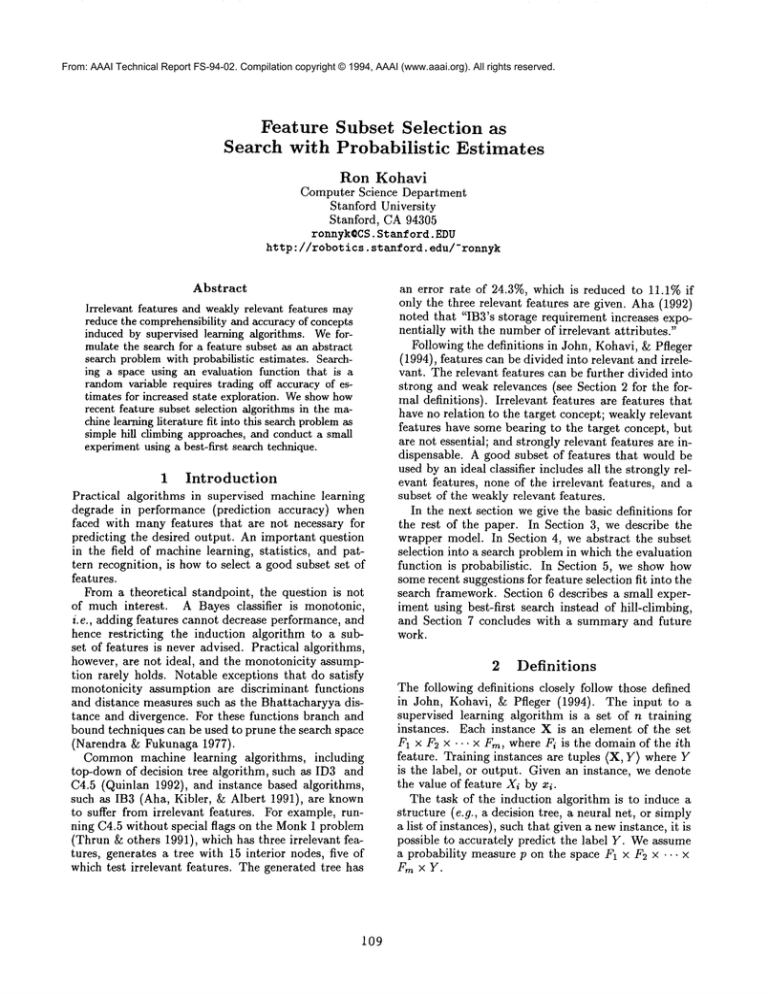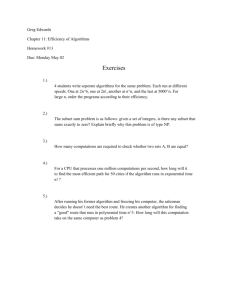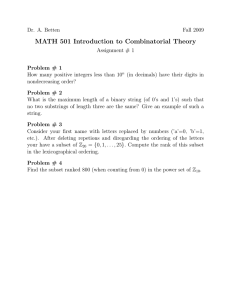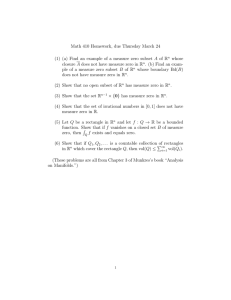
From: AAAI Technical Report FS-94-02. Compilation copyright © 1994, AAAI (www.aaai.org). All rights reserved.
Feature Subset Selection
as
Search with Probabilistic
Estimates
Ron Kohavi
Computer Science Department
Stanford University
Stanford, CA94305
ronnyk©CS.
Stanford.EDU
http://robotics.
stanford,
edu/-ronnyk
Abstract
Irrelevant features and weaklyrelevant features may
reduce the comprehensibility and accuracy of concepts
induced by supervised learning algorithms. Weformulate the search for a feature subset as an abstract
search problem with probabilistic estimates. Searching a space using an evaluation function that is a
randomvariable requires trading off accuracyof estimates for increased state exploration. Weshowhow
recent feature subset selection algorithms in the machine learning literature fit into this search problemas
simple hill climbing approaches, and conduct a small
experimentusing a best-first search technique.
1 Introduction
Practical algorithms in supervised machine learning
degrade in performance (prediction accuracy) when
faced with many features that are not necessary for
predicting the desired output. An important question
in the field of machine learning, statistics,
and pattern recognition, is howto select a good subset set of
features.
From a theoretical standpoint, the question is not
of much interest.
A Bayes classifier
is monotonic,
i.e., adding features cannot decrease performance, and
hence restricting
the induction algorithm to a subset of features is never advised. Practical algorithms,
however, are not ideal, and the monotonicity assumption rarely holds. Notable exceptions that do satisfy
monotonicity assumption are discriminant functions
and distance measures such as the Bhattacharyya distance and divergence. For these functions branch and
bound techniques can be used to prune the search space
(Narendra & Fukunaga 1977).
Commonmachine learning algorithms, including
top-down of decision tree algorithm, such as ID3 and
C4.5 (Quinlan 1992), and instance based algorithms,
such as IB3 (Aha, Kibler, & Albert 1991), are known
to suffer from irrelevant features. For example, running C4.5 without special flags on the Monk1 problem
(Thrun ~: others 1991), which has three irrelevant features, generates a tree with 15 interior nodes, five of
which test irrelevant features. The generated tree has
109
an error rate of 24.3%, which is reduced to 11.1% if
only the three relevant features are given. Aha (1992)
noted that "IB3’s storage requirement increases exponentially with the number of irrelevant attributes."
Following the definitions in John, Kohavi, & Pfleger
(1994), features can be divided into relevant and irrelevant. The relevant features can be further divided into
strong and weak relevances (see Section 2 for the formal definitions). Irrelevant features are features that
have no relation to the target concept; weakly relevant
features have some bearing to the target concept, but
are not essential; and strongly relevant features are indispensable. A good subset of features that would be
used by an ideal classifier includes all the strongly relevant features, none of the irrelevant features, and a
subset of the weakly relevant features.
In the next section we give the basic definitions for
the rest of the paper. In Section 3, we describe the
wrapper model. In Section 4, we abstract the subset
selection into a search problem in which the evaluation
function is probabilistic.
In Section 5, we show how
somerecent suggestions for feature selection fit into the
search framework. Section 6 describes a small experiment using best-first search instead of hill-climbing,
and Section 7 concludes with a summary and future
work.
2 Definitions
The following definitions closely follow those defined
in John, Kohavi, L: Pfleger (1994). The input to
supervised learning algorithm is a set of n training
instances. Each instance X is an element of the set
F1 × F2 × ¯ ¯. x Fro, where F~ is the domainof the ith
feature. Training instances are tuples (X, Y) where
is the label, or output. Given an instance, we denote
the value of feature Xi by zi.
The task of the induction algorithm is to induce a
structure (e.g., a decision tree, a neural net, or simply
a list of instances), such that given a newinstance, it is
possible to accurately predict the label Y. Weassume
a probability measure p on the space F1 × F2 × ..- ×
FmxY.
Let S,. be the set of all features except Xi, i.e., Si =
{X1,..., Xi-1, Xi+l,..., X,~}. Denote by si a valueassignment to all features in Si.
Definition 1 (Strong relevance)
Xi is strongly relevant iff there exists some xi, y, and
si for which p(Xi = xi, Si = si) > 0 such that
p(Y = y I xi = xi, = # p(y = v I =
Definition 2 (Weak relevance)
A feature Xi is weakly relevant iff it is not strongly
relevant, and there exists a subset of features S~ of Si
for which there exists some xi, y, and s~ with p(Xi
xi, S’i = s~) > 0 such that
pW = u I x, = = # p(r = u I =
A feature is relevant if it is either weakly relevant
or strongly relevant. A feature is irrelevant if it is not
relevant.
3 The Wrapper
Model
A good subset of features for an inductive learning algorithm should include a subset of the relevant features
that optimizes someperformance function, usually prediction accuracy.
The pattern recognition literature (Devijver & Kittier 1982), statistics literature (Miller 1990; Neter,
Wasserman, & Kutner 1990), and recent machine
learning papers (Almuallim & Dietterich 1991; Kira
Rendell 1992; Kononenko 1994) consist of many such
measures that are all based on the data alone. Most
measures in the pattern recognition and statistics literature are monotonic, i.e., for a sequence of nested
feature subsets F1 ~ F2 _D -.. D F~, the measure f
obeys f(F1) :> f(F~) > ... > f(Fk). Monotonic measures allow pruning the search space using a branch
and bound algorithm, but most machine learning induction algorithms do not obey the monotonic restriction. Even when branch and bound can be used, the
space is usually too big when there are more than 20
features, and suboptimal methods are used in practice.
All of the above measures and algorithms, however,
ignore the fact that induction algorithms are not optimal, and that most induction algorithms conduct a
very limited search in the space of possible structures.
Ignoring these limitations can lead to feature subsets
which are inappropriate for the induction algorithm
used. As was shown in by John, Kohavi, & Pfleger
(1994), even features with high predictive power may
impair the overall accuracy in some cases. Selecting a
subset of features must, therefore, not be based solely
on the intrinsic discriminant properties of the data, but
should be made relative to a given algorithm.
In the wrapper model, shownin Figure 1, the feature
subset selection is done using the induction algorithm
as a black box. The feature subset selection algorithm
conducts a search for a good subset using the induction algorithm itself as part of the evaluation function.
ii0
In order to evaluate the prediction accuracy of the induced structure, k-fold cross validation (Breiman et
al. 1984) can be used. The training data is split into
approximately equally sized partitions. The induction
algorithm is then run k times, each time using k - 1
partitions as the training set and the other partition
as the test set. The accuracy results from each of the
k runs are then averaged to produce the estimated accuracy.
4
Feature
Subset
Selection
as Search
The problem of feature subset selection is basically a
problem of state space search. Each state represents
a subset of features, and the goal is to find the state
with the best performance measure.
The wrapper model, which uses cross validation to
estimate accuracy, complicates the search problem further. The fact that k-fold cross validation returns an
estimate that is a random variable for k < n, implies
that there is uncertainty in the returned value.
One way to decrease the variance is to run k-fold
cross validation more than once and average the results, shuffling the data before each k-fold cross validation run. Averaging the results will yield a mean, such
that the variance of the mean depends on the number
of iterations conducted. Increasing the number of iterations shrinks the confidence interval for the mean,
but requires more time. The tradeoff between more
accurate estimates and more extensive exploration of
the search space leads to the following abstract search
problem.
Search with Probabillstic
Estimates Let S be a
state space with operators between states. Let f : S F-~
be an unbiased probabilistic evaluation function that
maps a state to a real number, indicating howgood the
state is. The number returned by f(s) comes from a
distribution :D(s) with meanf* (s), which is the actual
(unknown) value of the state. The goal is to find the
state s with the maximalvalue of f* (s).
The mapping to the feature subset selection problem is as follows. The states are the subsets, and
the operators are "add one feature," "delete one feature," etc. The evaluation function is the cross validation accuracy3
Searching in the space of feature subsets has been
studied for many years. Sequential backward elimination, sometimes called sequential backward selection, was introduced by Marill & Green in 1963. Kittler generalized the different variants including forward
methods, stepwise methods, and "plus t-take away
1Evaluationusing cross validation is pessimistically biased due to the fact that only part of the data is used for
training. The estimate from each fold is an unbiased estimator for that fold, whichcontains only n. (k - 1)/k of the
instances. For modelselection, this pessimismis of minor
importance.
Input
features
Feature subset search ]
Induction Algorithm [
IInduction
Algorithm
Figure 1: The wrapper model. The induction algorithm is used as a "black box" by the subset selection algorithm.
r." Branch and bound algorithms were introduced by
Narendra & Fukunaga (1977). Finally, more recent
papers attempt to use AI techniques, such as beam
search and bidirectional search (Siedlecki & Sklansky
1988), best first search (Xu, Van, & Chang 1989),
genetic algorithms (Vafai & De Jong 1992). All the
algorithms described above assume that the evaluation
function is deterministic. Whenthe evaluation function is a random variable, the search becomes more
complicated.
Greiner (1992) describes how a to conduct a hillclimbing search when the evaluation function is probabilistic.
The algorithm stops at a node that is a
local optimum with high probability.
Yah & Mukai
(1992) analyze an algorithm based on simulated annealing and show that it will find the global optimum
if given enough time.
5 Instantiations
of the Abstract
Search
Problem
In this section we look at three instantiations of the
abstract search problem.
5.1 Hill climbing
using the mean value
One simple approach used by John, Kohavi, & Pfleger
(1994) is to do a k-fold cross validation and use the
mean value as the estimate. This approach was used
with forward stepwise selection and backward stepwise
elimination.
Backwardstepwise elimination is a hill-climbing approach that starts with the full set of features and
greedily removes or adds one feature that improves performance, or degrades performance slightly. Forward
stepwise selection is a similar algorithm that starts
from the empty set of features.
The main disadvantage of this algorithm is that it
does not take into account the uncertainty in the estimated accuracy. In the empirical observations it was
noted that the values returned from the cross validation estimates had a large variance. This variance
causes the algorithm to stop prematurely both during
forward stepwise selection and during backward stepwise elimination.
iii
5.2
Hoeffding races
Maron & Moore (1994) in an approach very similar
Greiner (1992), attempt to shrink the confidence interval of the accuracy for a given set models, until one
model can be proven to be optimal with high probability. The evaluation function is a single step in leaveone-out cross validation, i.e., the algorithm is trained
on randomly chosen n - 1 instances and tested on the
one that is left.
The idea in the above paper is to race competing
models, until one is a clear winner. Modelsdrop out of
the race when the confidence interval of the accuracy
does not overlap with the confidence interval of the accuracy of the best model (this is analogous to imposing
a higher and lower bound on the estimation function
in the B* algorithm). The race ends when there is
winner, or when all n steps in the leave-one-out cross
validation have been executed. The confidence interval
is defined according to Hoeffding’s formula (Hoeffding
1963):
Pr(if(s)-f(s)
>
2e- 2m~2/ B2
where f(s) is the average of m evaluations and B
bounds the possible spread of point values. Given a
confidence level, one can determine e, and hence a confidence interval for f* (s), from the above formula.
The paper, however, does not discuss any search
heuristic, and assumes that a fixed set of models is
given by some external source.
5.3
Hill climbing utilizing
races
Moore8z Lee (1994) describe an algorithm for feature
subset selection that has both ingredients of the abstract problem--it has a search heuristic, and it uses
the probabilistic estimates in a non-trivial manner.
The algorithm does a forward selection and backward elimination (see Section 5.1), but instead of estimating the accuracy of each added (deleted) feature using leave-one-out cross validation, all the features that
can be added (deleted) are raced in parallel. Assuming that the distribution of f(s) is normal, confidence
intervals are used to eliminate some features from the
race.
Dataset
Baseline
Acc.
Breast-cancer
Chess
73.7%
Glass
Glass2
Heart-disease
Hepatitis
Horse-colic
Hypothyroid
Iris
Labor
Lymphography
Mushroom
Sick-euthyroid
Soybean-small
Vote
Votel
Average
30.6%
53.2%
58.2%
62.4%
86.5%
60.3%
94.8%
30.0%
64.7%
60.0%
31.1%
90.4%
C4.5
ACE.
74.7%
99.5%
C4.5-HCS
Acc.
AcE.
73.7%
93.9%
74.7%
97.4%
63.9%
72.7%
74.3%
61.1%
62.5%
80.0%
80.0%
79.2%
80.8%
82.7%
85.3%
79.2%
84.6%
85.3%
99.2%
92.0%
82.4%
80.9%
99.2%
94.0%
82.4%
76.0%
99.2%
92.0%
82.4%
78.0%
100.0%
97.8%
100.0%
95.2%
89.7%
86.9%
lOO.O%
97.7%
31.1% 100.0%
64.8%
64.8%
59.78%
C4.5-BFS
95.2%
88.3%
86.2%
78.0%
100.0%
97.8%
100.0%
95.2%
89.7%
87.4%
BFS Cpu
time (sec)
873
27289
937
515
787
2100
2073
10826
68
401
923
19937
13125
937
534
751
Subset
I,4,6,8
0,5,9,
13,14,
20,31,32,34
O,I,2,3
O,I,3,7
8, 11,12
4, 6,16,17
O,2,9,21
13,14,22
3
I,10
O,8,12,16
4,7,11,14,19
9,14,16,22
20,21
3
2,3,5
Table 1: Comparisonof C4.5 and C4.5 with best-FS feature subset selection.
Schematasearch is another search variant that allowstaking into account interactions between features.
Instead of starting with the empty or full set of features, the search begins with the unknown set of features. Each time a feature is chosen and raced between
being "in" or "out." All combinations of unknown features are used in equal probability, thus a feature that
should be "in" will win the race, even if correlated with
another feature.
Although this method uses the probabilistic
estimates in a Bayesian setting, the basic search strategy
is simple hill-climbing.
6 Experimental
Results
In order to estimate the utility
of broadening the
search, we used a best-first
search in the space of feature subsets. The initial node was the empty set of features and the evaluation function was a single 10-fold
CV.2 At each expansion step, best-first
search chooses
to expand an unexpanded node with the highest estimated accuracy. The search stops when five node expansions do not yield improved performance of more
than 0.1%.
The datasets
shown in Table 1 are the same ones
used in Holte’s paper (Holte 1993) from the UC Irvine
repository
(Murphy &: Aha 1994). For all datasets
that did not have a test set, we generated an indepen3dent sample of one third of the instances for testing.
The table shows the baseline accuracy, £e., a majority predictor; C4.5’s accuracy; C4.5’s accuracy for the
2The same 10-way split was done for all subsets.
3Note that the accuracies are from a single randomly
selected test set, not averaging over multiple runs as was
done by Holte.
112
subset selected by a hill-climbing search (C4.5-HCS);
C4.5’s accuracy for the subset selected by a best-first
search (C4.5-BFS); the CPU time for C4.5-BFS on
Sparc 10 512; and the subset selected by the best-first
search (feature numbers starting from zero).
The results show that the hill-climbing
search for a
good subset improve C4.5’s average accuracy by 0.7%,
and that the best-first
search strategy improves it by
1.2%. By themselves,
these improvements
may not
seem significant,
but it is well known that it is very
hard to improve on C4.5’s performance,
and in some
cases (e.g., glass2, heart-disease, horse-colic),
the improvements are substantial.
On some artificial
datasets,
we have seen more dramatic examples of the improvement of a good search
strategy.
For example, on the monkl dataset (Thrun
others 1991), C4.5’s accuracy is 75.7%, C4.5-HCS’s
accuracy is 75.0%, and C4.5-BFS’s accuracy is 88.9%.
On the Corral dataset (John, Kohavi, & Pfleger 1994),
C4.5’s accuracy is 81.2%, C4.5-HCS’s accuracy is 75%,
and C4.5-BFS’s accuracy is 100.0%.
7 Summary
and
Future
Work
We have abstracted the feature subset selection using
cross validation
into a search problem with a probabilistic
evaluation function. We have shown (Section 5)
how three different instantiations
of the abstract algorithm differ in their treatment of the evaluation function and search. While one algorithm ignores the fact
that the evaluation is probabilistic
and uses the mean
value of a series of evaluations (k-fold cross validation),
the other two use confidence intervals to aid in finding
the best state (subset) fast. The two search algorithms
examined are basic hill-climbing
algorithms.
Preliminary experiments using best-first
search and
simple 10-fold cross validation for evaluation, show
that broadening the search may indeed help. A more
extensive experiment utilizing the fact that the evaluation function is probabilistic is nowbeing conducted.
The algorithms discussed attempted to improve prediction accuracy. In manycases comprehensibility is
very important, even when resulting in a small loss of
accuracy. Biasing the algorithms towards smaller subsets may be important in such cases.
The search for a good subset is conducted in a very
large space. All algorithms mentioned in this paper
start the search either from the empty set of features,
or from the full set of features. Since an optimal
classifier should include all strongly relevant features,
it might be beneficial to estimate which features are
strongly relevant, and start the search from this subset.
Acknowledgments We wish to thank George John
and Karl Pfleger for our initial work on feature subset
selection. George John has been of great help in this
ongoing research. Wewish to thank Pat Langley for his
comments. The experimental section was done using
.t,4£C++, partly funded by ONRgrant N00014-94-10448 and NSF grant IRI-9116399.
References
Aha, D. W.; Kibler, D.; and Albert, M. K. 1991.
Instance-based learning algorithms. Machine Learning 6(1):37-66.
Aha, D.W. 1992. Tolerating
noisy, irrelevant
and novel attributes in instance-based learning algorithms. International Journal of Man-MachineStudies 36(1):267-287.
Almuallim, H., and Dietterich, T. G. 1991. Learning with manyirrelevant features. In Ninth National
Conference on Artificial Intelligence, 547-552. MIT
Press.
Breiman, L.; Friedman, J. H.; Olshen, R. A.; and
Stone, C. J. 1984. Classification and Regression Trees.
Wadsworth International
Group.
Devijver, P. A., and Kittler, J. 1982. Pattern Recognition: A Statistical Approach. Prentice-Hall International.
Greiner, R. 1992. Probabilistic hill climbing : Theory
and applications.
In Glasgow, J., and Hadley, R.,
eds., Proceedings of the Ninth Canadian Conference
on Artificial Intelligence, 60-67. Morgan Kaufmann.
Hoeffding, W. 1963. Probability inequalities for sums
of bounded random variables. Journal of the American Statistical Association 58:13-30.
Holte, R. C. 1993. Very simple classification rules perform well on most commonlyused datasets. Machine
Learning 11:63-90.
John, G.; Kohavi, R.; and Pfleger, K. 1994. Irrelevant
features and the subset selection problem. In Machine
113
Learning: Proceedings of the Eleventh International
Conference. Morgan Kaufmann.
Kira, K., and Rendell, L. A. 1992. The feature selection problem: Traditional methods and a new algorithm. In Tenth National Conference on Artificial
Intelligence, 129-134. MITPress.
Kononenko, I. 1994. Estimating attributes:
Analysis and extensions of Relief. In Proceedings of the
European Conference on Machine Learning.
Maron, O., and Moore, A. W. 1994. Hoeffding races:
Accelerating model selection search for classification
and function approximation. In Advances in Neural
Information Processing Systems, volume 6. Morgan
Kaufmann.
Miller, A. J. 1990. Subset Selection in Regression.
Chapman and Hall.
Moore, A. W., and Lee, M. S. 1994. Efficient algorithms for minimizing cross validation error. In Cohen, W. W., and Hirsh, H., eds., Machine Learning:
Proceedings of the Eleventh International Conference.
Morgan Kaufmann.
Murphy, P. M., and Aha, D. W. 1994. UCI repository of machine learning databases. For information
contact ml-repository@ics.uci.edu.
Narendra, M. P., and Fukunaga, K. 1977. A branch
and bound algorithm for feature subset selection.
IEEE Transactions on Computers C-26(9):917-922.
Neter, J.; Wasserman, W.; and Kutner, M. H. 1990.
Applied Linear Statistical Models. Irwin: Homewood,
IL, 3rd edition.
Quinlan, J. R. 1992. C4.5: Programs for Machine
Learning. Los Altos, California: Morgan Kaufmann.
Siedlecki, W., and Sklansky, J. 1988. On automatic
feature selection. International Journal of Pattern
Recognition and Artificial Intelligence 2(2):197-220.
Thrun, S. B., et al. 1991. The monk’s problems:
A performance comparison of different learning algorithms. Technical Report CMU-CS-91-197, Carnegie
Mellon University.
Vafai, H., and De Jong, K. 1992. Genetic algorithms
as a tool for feature selection in machinelearning. In
Fourth International Conference on Tools with Artificial Intelligence, 200-203. IEEE Computer Society
Press.
Xu, L.; Yan, P.; and Chang, T. 1989. Best first
strategy for feature selection. In Ninth International
Conference on Pattern Recognition, 706-708. IEEE
Computer Society Press.
Yan, D., and Mukai, H. 1992. Stochastic
discrete optimization. Siam J. Control and Optimization
30(3):594-612.






